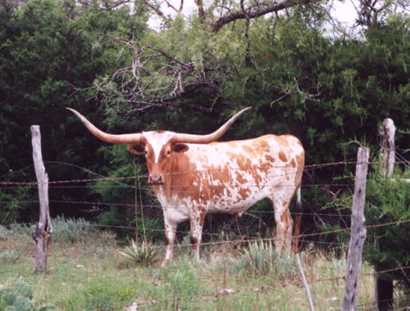|
|
Given
half a chance, any self-respecting Texan will try to claim that his
cowboy forebears invented trail driving.
From Zane Grey to Larry McMurtry, writers have turned the Texas trail
drive story into the Lone Star state’s version of the Odyssey -- a
long, adventurous trip from Texas to
the railhead in Kansas.
But all those longhorns that revitalized Texas’ post-Civil War economy
had to come from somewhere. And where the breed came from was the
interior of Mexico.
Via trail drive. |
 |
Unfortunately,
not as much is known of these first trail drives into Texas
as the later trail drives from Texas
beginning in the 1870s. Fortunately, Father Mariano Antonio Vasconcelos,
a Franciscan missionary who spent 14 years in the Spanish province
of Texas, kept a diary.
The padre did not wax on and on with descriptive prose, but the journal
he wrote offers some insight into Texas’
first trail drives.
“A drove of cattle left [Zacatecas] for the missions and Fr. Jose
Maria Camarena went as missionary,” Vasconcelos wrote on Oct. 13,
1777.
The trail drive to Texas lasted through
winter and into early spring.
“The animals of the missions of Texas arrived after 5 months and 11
days on the road,” Vasconcelos noted in his journal on March 24, 1788.
The “conductor” of the trail drive, Fray Jose Antonio Garcia, had
ridden into San Antonio
the day before, Vasconcelos noted. Garcia got only four days to enjoy
whatever amenities existed in the small frontier community before
leaving for the long return trip to the interior.
Clearly, pushing cattle across the Northern Mexico desert took longer
than making the trip without cattle. Garcia was back in Zacatecas
by April 15, his trip having taken only 18 days.
The Spanish rounded up cattle in the fall and spring, just as ranchers
still do today.
On July 16, 1792, Father Garcia was relieved “of his work as procurator
and conductor for the missions.” His successor, Father Vicente Parra,
left Zacatecas on October 13 with “the drove of animals with supplies
for the missions of Texas.”
Maybe because of inexperience, or bad weather, it took Parra longer
to make the trip to San
Antonio and back. He did not return to Zacatecas until April 15,
1793, some six months later.
In
addition to offering some insight into the beginnings of the Texas
cattle industry, the diary-keeping priest chronicled the hazards of
colonial life in the remote province, particularly the dangers facing
travelers and cattlemen. During the first half of 1781, 16 persons,
both Spaniards and missionary Indians, died at the hands of Comanches.
“Hostile Indians killed six soldiers who were bringing forage for
the horses,” Vasconcelos wrote on Feb. 6, 1781. “Two or three days
later Mariscada [a Spanish officer whose first name was not given]
went out to avenge the deaths and, returning by way of el Paxtle,
left five citizens to get the hide of a cow. While they were doing
this, the Indians attacked and killed two; the other three escaped.”
On March 18, 1781, a man and his son left their ranch near present
Floresville
to round up their cattle. “They were met by Indians and killed,” the
priest wrote.
The threat to these early-day cattlemen continued. On August 5 that
year, Vasconcelos wrote, “The leader and a few cowboys [the missionary
wrote in Spanish, of course, using the word ‘vaqueros’ for cowboys]
from Mission San Juan Capistrano were taking cattle for rationing
from the corral at Mission Concepcion where Comanche Indians appear
near Mission San Jose. In the ensuing struggle [two vaqueros] were
wounded.”
Despite the hazards in Texas, Father
Vasconcelos died of natural causes on July 20, 1815 near Guadalajara
and was buried in the cathedral there. His diary was not discovered
by modern historians until 1971, when Father Benedict Leutenegger
of San Antonio found
it in a convent in the small Mexican town of Guadalupe, near Zacatecas.
Leutenegger had it microfilmed for the Old Spanish Missions Historical
Research Library in San
Antonio and published a translation of it in 1977.
© Mike Cox
"Texas Tales"
March 21, 2005 column
Related Topics: Columns | Ranching,
Cattle Drives | Texas | |
|
|
